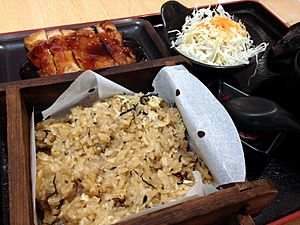Okowa facts for kids

Okowa bento
|
|
| Alternative names | おこわ (強飯) |
|---|---|
| Type | steamed rice dish |
| Place of origin | Japan |
| Associated national cuisine | Japanese |
| Serving temperature | Room Temperature |
| Main ingredients | rice, meat or vegetables |
| Ingredients generally used | wild herbs (sansai okowa) and vessel chestnuts (kuri okowa) |
| Variations | Sekihan or Kowameshi |
Okowa (おこわ) is a special Japanese dish. It is made from steamed sticky, or "glutinous," rice. People often mix it with tasty ingredients like meat or vegetables.
Sometimes, Okowa includes wild herbs, which is called sansai okowa. Another popular type is kuri okowa, made with chestnuts. For special events, Okowa is often mixed with Azuki beans. These beans give the rice a pretty red color, making it look festive.
Okowa is usually eaten at room temperature. This makes it perfect for onigiri, which are Japanese rice balls. It also freezes well, so you can save it for later!
Contents
What Does "Okowa" Mean?
The word "Okowa" comes from a longer Japanese word, Kowameshi. Kowameshi means "hard rice." This name describes the firm texture of the sticky rice. Sometimes, dishes that mix different kinds of rice are also called Okowa.
A Short History of Okowa
Long ago, "Okowa" simply meant plain sticky rice that was cooked by steaming. Over time, the meaning changed. Today, when people say "Okowa," they often mean a red rice dish called Sekihan. Plain white steamed rice now has a different name.
Fun Okowa Variations
Okowa is super versatile! You can mix it with almost any kind of meat or vegetable. The basic idea is sticky rice with different flavors.
Some common additions include:
- Sweet potato
- Pre-cooked chestnuts
- Boiled bamboo shoots
You can also add meats like:
- Char siu pork
- Roasted duck
- Diced sausage
Other famous Japanese rice dishes include kayu (a rice porridge), dango (sweet rice dumplings), mochi (chewy rice cakes), and, of course, sushi.
How to Make Okowa Rice Balls
Making Okowa rice balls is a fun cooking project! Here's what you need and how to do it:
Ingredients You Will Need
- Short-grain Glutinous rice
- Sesame oil
- Dashi (Japanese soup stock)
- Soy sauce
- Mirin (sweet cooking wine)
- Salt
- Ginger
- Chopped mushrooms
- Chopped carrots
- Sweet potato
- Chestnuts
- Spring onions
- Cooked fish
- A sheet of nori (seaweed)
Steps to Prepare Okowa
- First, wash the rice with water. Let it drain for about 30 minutes.
- Put the drained rice into a rice cooker. Add the dashi stock, mirin, sesame oil, salt, and sake. Let it sit for another 30 minutes.
- Next, add your meat, vegetables, and ginger to the cooker.
- Set your rice cooker to the "short-grain rice" setting.
- If you are using a saucepan, cover it with a lid. Bring the mixture to a boil once. Then, turn the heat down low and cook for 12 minutes.
- Turn off the heat and let the rice steam for another 10 minutes with the lid on.
- Once cooked, let the rice cool down to room temperature.
- Shape the rice into small triangles or balls.
- Finally, wrap the bottom of each rice ball with a piece of nori seaweed. Enjoy your homemade Okowa!

